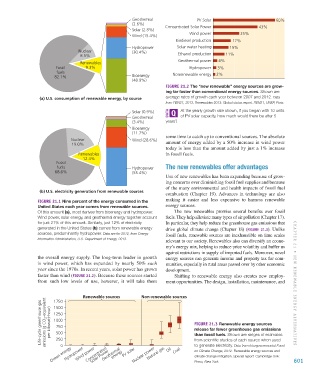Page 602 - Environment: The Science Behind the Stories
P. 602
Geothermal PV Solar 60%
(2.6%) Concentrated Solar Power 43%
Solar (2.8%)
Wind (15.4%) Wind power 25%
Biodiesel production 17%
Hydropower Solar water heating 15%
Nuclear (30.4%)
8.5% Ethanol production 11%
Renewables Geothermal power 4%
Fossil 9.3% Hydropower 3%
fuels Nonrenewable energy 2%
82.1% Bioenergy
(48.9%)
Figure 21.2 The “new renewable” energy sources are grow-
ing far faster than conventional energy sources. Shown are
(a) U.S. consumption of renewable energy, by source average rates of growth each year between 2007 and 2012. Data
from REN21, 2013. Renewables 2013: Global status report. REN21, UNEP, Paris.
Solar (0.9%) At the yearly growth rate shown, if you began with 10 units
Geothermal of PV solar capacity, how much would there be after 5
(3.4%) years?
Bioenergy
(11.7%)
some time to catch up to conventional sources. The absolute
Nuclear Wind (28.6%) amount of energy added by a 50% increase in wind power
19.0%
today is less than the amount added by just a 1% increase
Renewables in fossil fuels.
12.4%
Fossil
fuels Hydropower The new renewables offer advantages
68.6% (55.4%)
Use of new renewables has been expanding because of grow-
ing concerns over diminishing fossil fuel supplies and because
of the many environmental and health impacts of fossil fuel
(b) U.S. electricity generation from renewable sources
combustion (Chapter 19). Advances in technology are also
Figure 21.1 Nine percent of the energy consumed in the making it easier and less expensive to harness renewable
United States each year comes from renewable sources. energy sources.
Of this amount (a), most derives from bioenergy and hydropower. The new renewables promise several benefits over fossil
Wind power, solar energy, and geothermal energy together account fuels. They help alleviate many types of air pollution (Chapter 17).
for just 21% of this amount. Similarly, just 12% of electricity In particular, they help reduce the greenhouse gas emissions that
generated in the United States (b) comes from renewable energy drive global climate change (Chapter 18) (Figure 21.3). Unlike
sources, predominantly hydropower. Data are for 2012, from Energy fossil fuels, renewable sources are inexhaustible on time scales
Information Administration, U.S. Department of Energy, 2013.
relevant to our society. Renewables also can diversify an econo-
my’s energy mix, helping to reduce price volatility and buffer us
against restrictions in supply of imported fuels. Moreover, novel
the overall energy supply. The long-term leader in growth energy sources can generate income and property tax for com-
is wind power, which has expanded by nearly 50% each munities, especially in rural areas passed over by other economic
year since the 1970s. In recent years, solar power has grown development.
faster than wind (Figure 21.2). Because these sources started Shifting to renewable energy also creates new employ-
from such low levels of use, however, it will take them ment opportunities. The design, installation, maintenance, and CHAPTER 21 • N E w R ENE wA bl E E NER gy AlTERN AT iv E s
Renewable sources Non-renewable sources
1750
Life-cycle greenhouse gas emissions (g CO 2 -equivalent per kilowatt-hour) 1250 Figure 21.3 Renewable energy sources
1500
1000
750
release far fewer greenhouse gas emissions
500
than fossil fuels. Shown are ranges of estimates
250
to generate electricity. Data from Intergovernmental Panel
0
Concentrated
Hydropower
Ocean energy Wind power Solar Power energy PV solar Nuclear power Oil Coal from scientific studies of each source when used 601
Natural gas
Geothermal
on Climate Change, 2012. Renewable energy sources and
climate change mitigation. Special report. Cambridge Univ.
Press, New York.
M21_WITH7428_05_SE_C21.indd 601 12/12/14 4:29 PM

